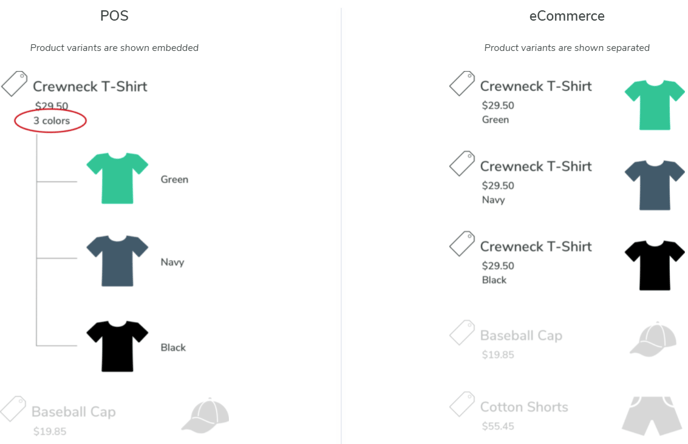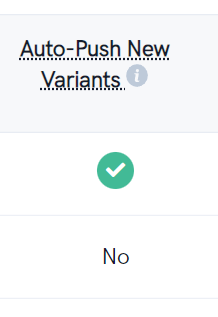Here are some tips and tricks on how to make items matchable so you can use the Link Report effectively.
Overview
There may be some items that will show up with a yellow exclamation mark ⚠️ next to them on the Link Report, or there may be items that do not show up on the Link Report at all! This document will give you some troubleshooting tips and tricks to help you fix these problems. If you run in to any trouble or need some help resolving these mis-matches or errors, please contact Support or submit a Support Ticket! Remember, we're here to chat with you Monday through Friday from 8AM to 4PM Mountain Time as well.
Not sure what the Link Report is? Refer to this article for a quick refresher!
Requirements to Link Products
1. Products must be listed on both platforms!
If you have a new Point of Sale or eCommerce system with no products entered as of yet, you do not need to link products. You should, instead, push them to migrate them over to the opposite platform. See the article on pushing products for more information!
2. Your Point of Sale and eCommerce products must have something in common: a SKU number, UPC/Barcode number, or product title.
If you want to make your own SKU numbers, check out this information on generating your own SKUs!
Note: If the product titles are the only data type that match between your platforms, the products must also have a matching brand or price in order for SKU IQ to detect the match. The brand field can be blank on both sides, but you must have a price!
3. Products must have the same structure between both platforms in order to be matched!
(See the exception about Clover.)
This means that each item must either be a parent product with matching variants OR be an individual product with no variants on both platforms.
In the image below, the Point of Sale shows an item with variants (AKA a matrix for Lightspeed users) with the eCommerce platform shows the same items listed as separate items. Although they may be considered the same product to us humans, SKU IQ requires that both products have the same structure in order to be linked properly.

A simpler way to look at it is in this structure:
There is an exception to this rule. In the case of Clover Point of Sales - you can match an individual item to a variable item on the opposing eCommerce! Take a look at this diagram:
In order for this to work, each product must have a matching SKU number or UPC. In the instance of Clover, we will only be able to perform this unique match by SKU number.
Please note that this combination is NOT possible at this time:
4. Products may not be duplicated in your Point of Sale or eCommerce platform. Each item must be individualized either with a unique product title, UPC, or SKU number.
Each item, regardless of it is a variable item or not, should have unique identifiers. If you plan to match based on Product Title rather than SKU or UPC, you must make sure that the variants have unique identifiers in the Color and/or Size fields. SKU IQ is unable to identify custom fields at this moment as unique identifiers.
In the image below, there are no other unique identifiers than the Products' Title. These will not be able to match to their opposing eCommerce partners as SKU IQ will not be able to differentiate which goes with which - just like in Go Fish or Old Maid.
5. Products must not have duplicated variants.
In the image below, you'll see that there are several models for this item. Note that the colors for all are "BLACK" and there are duplicates of the various sizes. The unique identifier here would be the Grade of the product, but SKU IQ does not recognize this field - this makes SKU IQ think that the variants here are duplicated. In order to avoid this, Size or Color must be changed to have a more unique identifier. In this case, since all of the items are Black, adding the Grade in to the Color category would satisfy this rule.
6. Products that you want to link must be in Active (published) status and not in archieved or draft status.
SKU IQ will not make a linking relationship between items that aren't "real". That means that all items you want to form a linking relationship between must be in published status.
How Do I Fix Un-linkable Items?
It's fairly simple to fix un-linkable items. Here are a couple different options you can try. Before you do anything, we highly recommend backing up your data to prevent any kind of data loss in case you make a mistake.
1. Archive On One Side
Pick one of your platforms to perform this action on: archive the product that has the mismatched structure. Then create a new product (on that same platform) that has the correct product structure. This is usually easier to do on your eCommerce platform.
2. Delete On One Side
Delete the item(s) from one platform (ideally the one that has the incorrect structure) and push the product from the correct platform to the other side. See this article about pushing for details on how to do so. You may want to check out how data syncs between your platforms on the respective Integration Pages to see which side it may be easier to do this on.
3. Edit the products within your Point of Sale or eCommerce so that they have matching attributes and matching structures.
This option is not ideal as some integrations do not push new variants at all. Please check your platforms on the Integration Pages before doing this. If your integration reports that "Auto-Pushing New Variants" is not supported (indicated by "No" rather than a green checkmark), this option is NOT a good idea.

If you only need to add a SKU or UPC, this option is perfectly fine to use and would be the easiest of the three.
💡Tip: If you have made multiple edits to multiple products in a short period of time (less than 30 minutes), you may need to contact Support for us to perform a reimport of your product catalog. This way SKU IQ can capture and reflect all of the latest changes. Depending on the polling times for your platforms, some changes may take longer than others to reflect.
